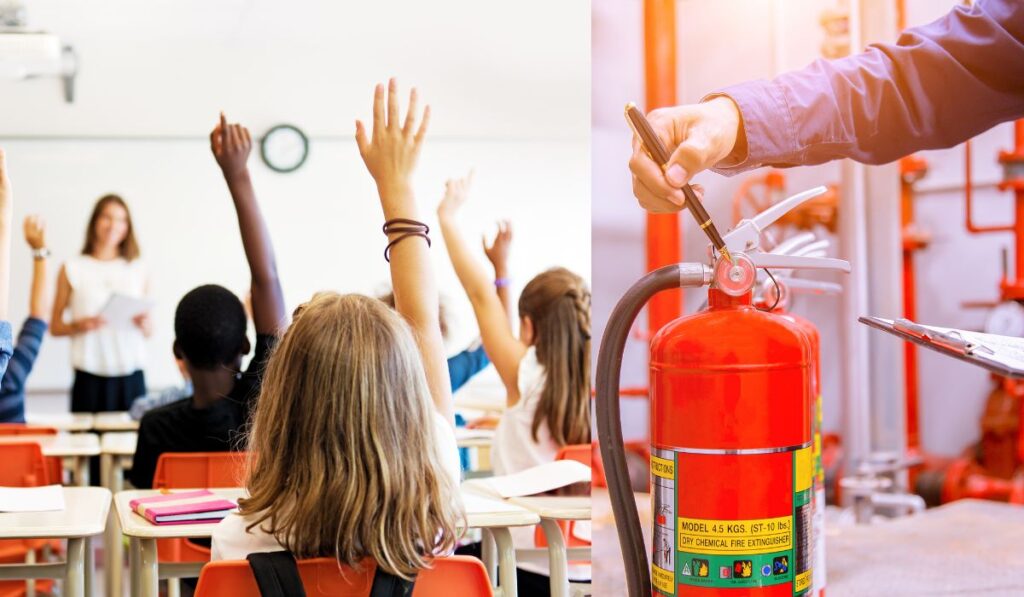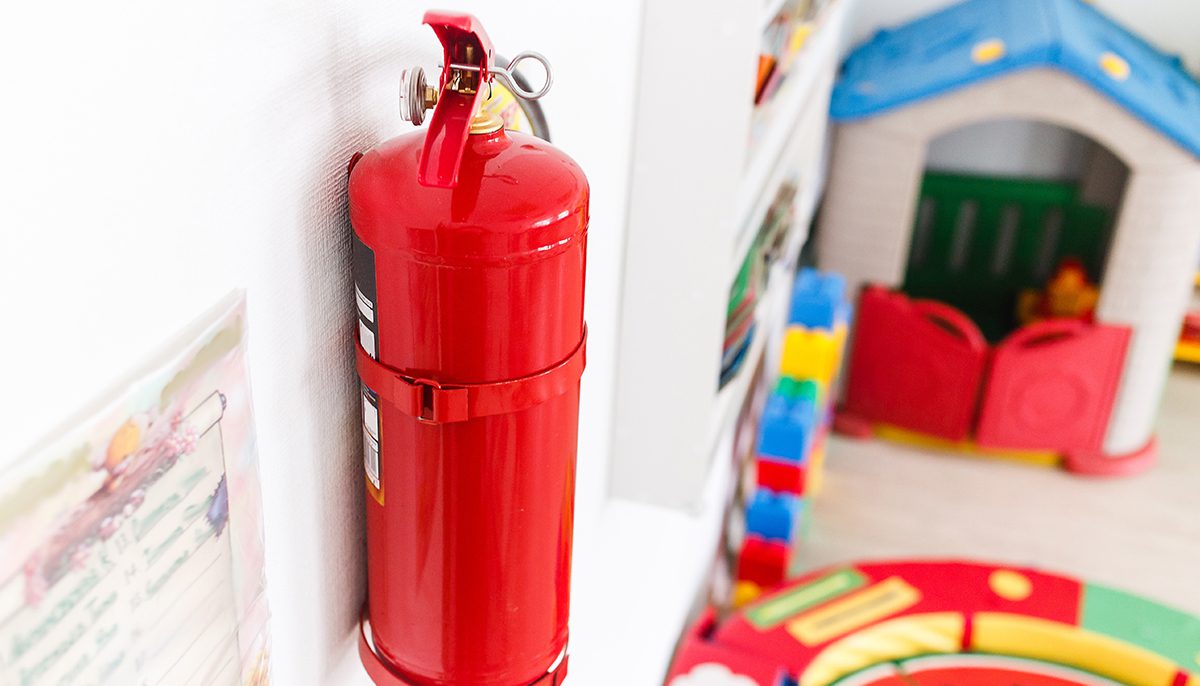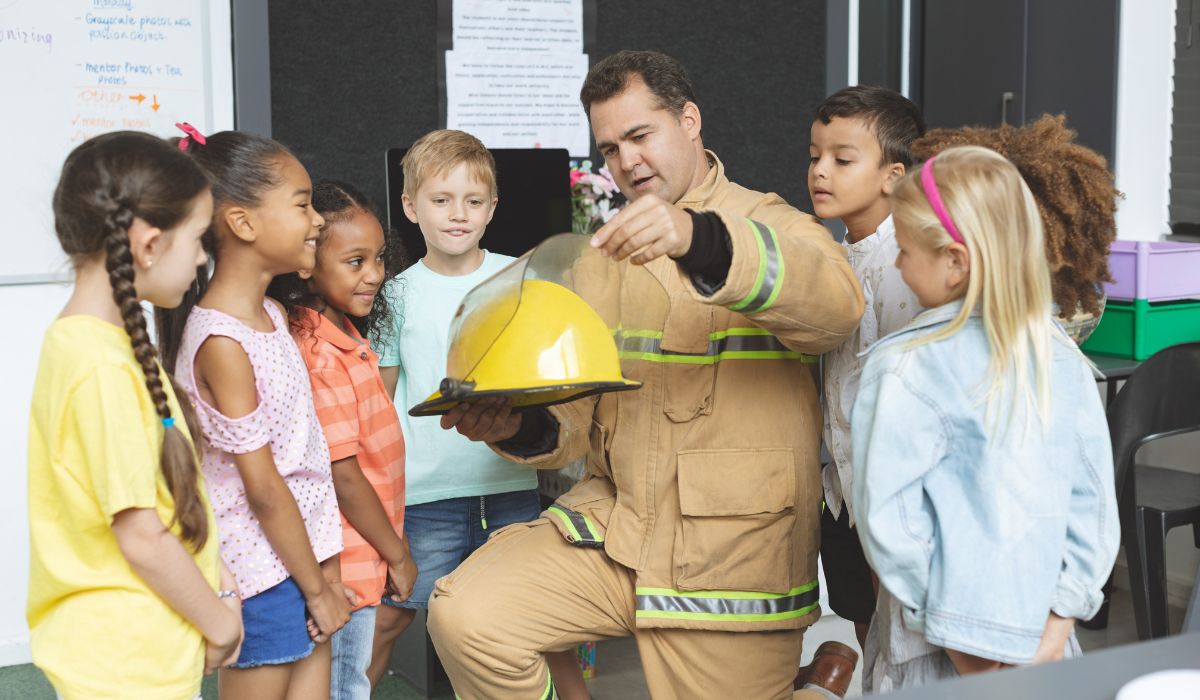Fire safety in schools is essential for protecting students and staff. It encompasses measures to prevent, respond to, and mitigate fire-related incidents.
Ensuring fire safety in schools involves a comprehensive approach that includes regular risk assessments, installation of fire detection and suppression systems, and robust evacuation plans. Equipping school buildings with appropriate fire exits, alarms, and extinguishers is critical. Teaching students and staff about fire hazards and response procedures through drills and educational sessions is equally important.
Compliance with local and national fire safety standards ensures a well-prepared environment that can significantly reduce the risk of fire-related injuries or fatalities. Maintaining a vigilant stance on fire safety not only shields lives but also safeguards the institution’s infrastructure and educational resources.
The Gravity Of Fire Safety In Schools

Imagine a school bustling with life. Now, picture an unexpected fire erupting. Panic, fear, and chaos would ensue. This is not a scene from a movie, but a potential reality if fire safety is not treated with the utmost importance. In an environment where young minds learn and grow, safety should be a top priority. Ensuring robust fire safety measures can mean the difference between life and death.
Statistics Of School Fires
Fires in schools are more common than we wish to believe. These statistics are not to scare but to bring awareness to this critical issue:
- Every year, fire departments respond to over 4,000 school fires.
- The majority of these fires start in kitchen areas or from electrical malfunctions.
- Direct property damage adds up to millions of dollars annually.
- By understanding these figures, we can push for changes and prevent future incidents.
Consequences Of Poor Fire Safety Measures
The consequences of neglecting fire safety in schools can be severe and multifaceted:
| Area | Consequence |
|---|---|
| Physical Harm | Injuries or potentially fatal accidents can occur. |
| Educational Impact | Lost classroom time and disruption to learning. |
| Emotional Distress | Students and staff may suffer from trauma and anxiety. |
| Financial Cost | Repairs and insurance claims can drain resources. |
| Reputation Damage | A school’s standing within the community could decline. |
By recognizing these potential consequences, schools can ascertain the critical need for comprehensive fire safety protocols.
Legislation And Codes For School Safety
Keeping students safe is the top priority of every school. Legislation and Codes for School Safety play a crucial role. They ensure that all educational institutions follow strict fire safety protocols. Let’s explore the rules and compliance every school must adhere to.
Local And National Fire Safety Regulations
All schools must follow specific fire safety rules. These rules keep everyone safe. They come from both local and national authorities. Schools need to know and follow these rules properly.
- Local Fire Codes: Different areas have unique risks. Local codes are designed to address these.
- National Standards: These are broad rules that apply to all schools across the country.
It’s important for schools to stay updated on all regulations. This ensures maximum safety for staff and students.
Compliance Requirements For Educational Institutions
Schools must meet certain standards to be safe. These are called compliance requirements. They help schools check if they are doing everything right to prevent fires.
| Requirement | Description |
|---|---|
| Fire Drills | Practice evacuations regularly so everyone knows what to do during a real fire. |
| Fire Alarms and Exits | Make sure alarms are working and exits are clear and easy to find. |
| Inspections | Have experts check the school to make sure it is safe from fire risks. |
Schools must keep records of safety measures. Inspection reports and drill logs are important documents. They show that the school understands and follows the rules for safety.
Risk Assessment And Prevention Strategies
Ensuring the safety of students and staff in schools is crucial. Risk Assessment and Prevention Strategies play a vital role. They help schools identify potential fire hazards before they become dangerous. Effective strategies can significantly reduce the risk of fire. They keep everyone safe and secure.
Conducting Routine Fire Risk Assessments
Regular fire risk assessments are essential. They help schools find and address fire hazards. Schools need to check all areas. This includes classrooms, labs, and cafeterias.
- Identify sources of ignition like electrical equipment or heating.
- Spot combustible materials such as paper or textiles.
- Examine fire safety measures in place, like alarms and extinguishers.
Professional assessors or trained staff can do these assessments. They make a record of their findings. They also create an action plan.
Preventative Measures To Mitigate Fire Risks
| Preventative Measure | Details |
|---|---|
| Fire Drills | Regular drills ensure everyone knows what to do during a fire. |
| Clear Exits | All exit routes must be free from blockages. |
| Staff Training | Staff should know how to use fire extinguishers and first aid. |
| Maintenance Checks | Check systems like alarms and sprinklers regularly. |
Clear communication is key. Signs and instructions should be easy to understand. Schools must have emergency contact information updated and accessible.

Credit: www.tfp1.com
Equipment Essentials For Fire Protection
The right tools can save lives. Fire safety in schools starts with having the correct equipment. Schools must ensure they have the essential devices for fire prevention and containment. No one wants to think about worst-case scenarios, but being prepared is vital. The essentials include extinguishers, smoke detectors, and sprinkler systems. Let’s explore each to understand their importance.
Fire Extinguishers And Their Strategic Placement
Fire extinguishers are the first line of defense against small fires. It is crucial to have them ready and within reach. Here are some tips for placing extinguishers:
- Visible and Accessible: Place extinguishers in plain sight and where they are easy to grab.
- Multiple Locations: Install them in hallways, near classrooms, and in areas like cafeterias and gyms.
- Height Consideration: Mount them at a height that both teachers and older students can easily access.
- Instruction Labels: Ensure they have clear, bold instructions so anyone can use them if necessary.
Smoke Detectors And Sprinkler Systems Installation
Early detection saves lives. Smoke detectors sound the alarm at the first sign of fire. Sprinkler systems act fast to control the fire. Their installation must meet these standards:
| System Type | Location | Regular Maintenance |
|---|---|---|
| Smoke Detectors | Throughout all school zones | Monthly checks |
| Sprinkler Systems | Areas of high fire risk | Annual inspections |
Smoke detectors should be on every floor. They belong inside classrooms and communal areas. Sprinkler systems need strategic placement, especially in science labs and kitchens. Schools must conduct regular tests. They ensure functionality when it matters most.
Designing School Infrastructure For Fire Safety
Fire safety in schools is not just about drills and extinguishers. It starts with the very design of the building. A well-thought-out structure can save lives during a fire emergency. Let’s explore key elements of designing school infrastructure with fire safety in mind.
Fire-resistant Materials In Construction
Building a fire-safe school begins with the right materials. Structures should feature fire-resistant materials. These are some examples:
- Fire-retardant wood slows down the spread of flames.
- Gypsum boards can resist fire for hours.
- Concrete and brick are naturally fire-resistant.
- Use steel with fireproof coatings to prevent collapse.
Furnishings and decorations must also be non-combustible or flame-retardant. Classrooms will be safer with these choices.
Emergency Exit Routes And Accessibility
Every second counts in a fire. Schools need clear emergency exit routes that everyone can reach. Follow these guidelines:
- Include multiple exits in every area of the school.
- Keep pathways unblocked at all times.
- Exit signs should be bright and visible.
- Design wheelchair-accessible routes for inclusivity.
Practice evacuation regularly so every student knows which way to go. Equip exits with panic hardware for quick opening.
Each classroom should have a door to the outside. This ensures a direct escape route. Schools should conduct monthly fire drills. This prepares students and staff for quick evacuations.
Creating A Fire Safety Culture In Schools
Creating a Fire Safety Culture in Schools is pivotal. School grounds should be the epitome of safety. Fostering an environment where everyone understands the importance of fire safety assures parents, educators, and students alike. It’s not just about having fire extinguishers on hand but about ingraining fire safety into the school ethos. Let’s explore how schools can achieve this crucial goal.
Regular Fire Drills And Training Sessions
Scheduled fire drills prepare everyone for emergencies. Like pop quizzes test knowledge, fire drills test readiness. These drills should happen unannounced, ensuring responses mirror real-life scenarios. Drills cover everything from hearing the fire alarm to evacuating the building safely. It is important that these are frequent, with a goal of seamless execution.
- Monthly fire drills
- Annual training for all staff
- Special sessions for new students and staff
| Group | Frequency |
|---|---|
| Entire School | Monthly |
| New Staff | Upon Hiring |
| New Students | At Orientation |
Educating Students And Staff On Fire Safety Protocols
Knowledge is key. Fire safety education ensures everyone knows their role when an alarm sounds. Training includes using fire extinguishers, recognizing fire hazards, and knowing the school’s evacuation routes. Interactive sessions with local firefighters can engage and educate effectively.
- Understanding the use of fire extinguishers
- Identifying and reporting potential fire hazards
- Learning the specific evacuation plan for each part of the school
Visual aids, such as posters and signs, reinforce these lessons. Every classroom should display these reminders prominently. Easy access to this information can save lives.
Remember: Regular practice and education build confidence and competence. This secures a culture of fire safety in our schools.
Emergency Response Plan Activation
An effective Emergency Response Plan Activation is crucial for safeguarding the lives of students and staff in schools. In the event of a fire, preparedness becomes the difference between chaos and calm, danger and safety. Let’s dive into the essential actions schools must take to ensure everyone knows what to do when flames flare.
Steps To Take When A Fire Occurs
- Sound the Alarm: Immediately trigger the school’s fire alarm to alert everyone.
- Evacuate: Follow pre-determined escape routes swiftly and calmly.
- Assembly Point: Gather at the designated safe area outside the building.
- Roll Call: Teachers conduct a headcount to ensure no one is missing.
- Never Re-enter: Remind everyone not to go back into the building.
Coordination With Local Fire Department
Maintaining a strong line of communication with the local fire department is vital for every school. Let’s look at the steps schools take to collaborate with firefighters:
- Pre-Incident Planning: Share building layouts and access points with fire officials.
- Training Sessions: Participate in joint drills to perfect emergency response times.
- Instant Alert: Ensure the fire department is one of the first to be notified in an emergency.
- Continual Updates: Provide current school activities and special events information.
Maintaining And Updating Fire Safety Policies
Keeping students and staff safe is crucial in any educational institution. A key element in ensuring this safety is the regular maintenance and updating of fire safety policies.” Fire risks evolve with new technologies and buildings age. That’s why schools must stay one step ahead. Outdated fire safety policies can put lives at risk.
Continuous assessment and improvements to these policies can lead to a safer learning environment. Let’s explore how schools can stay diligent with their fire safety efforts.
Regular Reviews Of Fire Safety Practices
Fire safety is not a “set and forget” service. It requires constant attention. Schools need to regularly review their fire safety practices. A proactive approach to fire safety prevents potential disasters. The following are key steps in maintaining robust fire safety practices:
- Annual audits of the existing fire safety measures.
- Consultation with fire safety professionals to identify gaps.
- Engagement of staff and students in regular fire drills.
Incorporating New Technologies And Methods
In the digital age, incorporating cutting-edge technologies into fire safety is a must. Advancements in fire detection and suppression offer enhanced protection. Schools should explore these options:
- Smart smoke detectors that send alerts to designated personnel.
- Installation of automated sprinkler systems in all areas.
- Use of fire-resistant materials in new construction.
Updating fire safety policies is not just about hardware. It also includes educating the community on best practices and new technologies. Training sessions for staff and information sessions for students make everyone a safety advocate.
Case Studies: Lessons Learned From School Fires
Understanding the importance of fire safety in schools is non-negotiable. By studying past.fire incidents, valuable insights emerge. Such analysis offers a roadmap for successful interventions and strategies to keep our schools safer. Let’s dive into real-life cases to extract these critical lessons.
Successful Interventions In Fire Emergencies
School fires demand immediate action. The stories below highlight quick thinking and preparedness that saved lives.
- Regular drills make students and teachers ready for a real emergency.
- In Case Study A, a well-practiced evacuation plan led to all students exiting safely within minutes.
- Use of fire-retardant materials in Case Study B gave everyone more time to get out.
In both cases, emergency teams credited these interventions with preventing injuries. They now serve as models for other schools.
Analysis Of Fire Incidents And Improved Strategies
After a fire occurs, schools can learn much from studying it closely.
- Identify what started the fire.
- Review how effective the response was.
- Plan future improvements.
Case Study C found that outdated equipment was to blame. The school then invested in modern fire alarms and sprinklers. Such changes are critical preventative measures to reduce risk and increase safety for everyone.
| Case | Cause of Fire | Changes Implemented |
|---|---|---|
| Case Study C | Electrical Fault | New Alarms and Sprinklers |
| Case Study D | Chemistry Lab Accident | Improved Lab Safety Training |
By sharing these experiences, schools can build a knowledge base for better fire safety protocols. This proactive approach is essential to ensure the well-being of students and staff alike.
Resources And Support For Fire Safety In Schools
Keeping our schools safe is a top priority. Fire safety measures help protect students and staff. Schools need resources and support to maintain these safety standards. Let’s explore the opportunities for enhancing fire safety in educational environments.
Grants And Funding For Fire Safety Improvements
Grants and funding are available to help schools upgrade their fire safety protocols. Several programs offer financial assistance for this purpose:
- Federal grants like the FEMA Assistance to Firefighters Grant Program.
- State-specific education grants that focus on school safety improvements.
- Private foundations that contribute to public school safety initiatives.
| Grant Type | Eligibility | Application Period |
|---|---|---|
| Federal | All public schools | Varies by year |
| State | Public schools in the respective state | Check with state |
| Private | Mostly public, some private schools | Open year-round |
Applying for these grants involves submitting safety plans and estimates. Start early to meet deadlines!
Partnerships With Safety Organizations
Schools can partner with local safety organizations. These partnerships provide:
- Expert fire safety audits of school premises.
- Fire drills and emergency training for students and staff.
- Access to resources like brochures, posters, and educational materials.
Connecting with safety organizations offers vital support. Look for local fire departments, nonprofits, and educational groups focusing on fire safety.
Frequently Asked Questions Of Fire Safety In Schools
What Are The Five Basic Fire Safety Practices?
1. Install and maintain smoke alarms on each floor of your building. 2. Regularly check and practice your fire escape plan. 3. Keep flammable materials away from heat sources. 4. Use electrical equipment responsibly and repair faulty wiring promptly. 5. Have fire extinguishers accessible and know how to use them.
How Do You Teach Students About Fire Safety?
To teach fire safety, start with clear evacuation plans. Use engaging videos and simulations for practical understanding. Demonstrate how to use fire extinguishers. Emphasize stop, drop, and roll. Conduct regular fire drills for hands-on practice.
What Are The Rules For Fire Safety?
For fire safety, always maintain working smoke alarms, plan and practice escape routes, keep fire extinguishers handy, avoid overloading electrical sockets, and store flammable materials safely.
What Are Two Ways To Prevent Fires And Fire Related Injuries In The Classroom?
Keep flammable materials away from heat sources and regularly inspect electrical equipment. Ensure smoke detectors and fire extinguishers are in working order and accessible.
Conclusion
Ensuring the safety of students and staff is paramount. Regular drills and updated safety plans are non-negotiable. Schools must team up with fire experts to safeguard our future. Together, we can create secure learning environments for all. Let’s prioritize fire safety in education today.

I’m Abdus Sobur, a highly skilled and professional Fire Safety Officer with a passion for safeguarding lives and property. Over the course of my career, I’ve conducted numerous successful fire safety audits, earning a reputation for excellence in ensuring public safety.
In addition to my role as a Fire Safety Officer, I’m also dedicated to raising awareness about the importance of fire safety. Through my blog, I share insights into the functions of different fire safety equipment, aiming to empower individuals with the knowledge they need to protect themselves and their communities.
I’m driven by a deep commitment to promoting fire safety awareness and preventing fire-related incidents.

